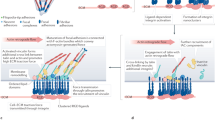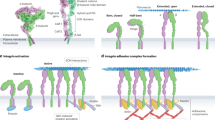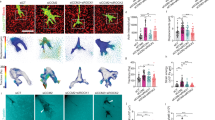Abstract
Gradients of chemorepellent factors released from myelin may impair axon pathfinding and neuroregeneration after injury. We found that, analogously to the process of chemotaxis in invasive tumor cells, axonal growth cones of Xenopus spinal neurons modulate the functional distribution of integrin receptors during chemorepulsion induced by myelin-associated glycoprotein (MAG). A focal MAG gradient induced polarized endocytosis and concomitant asymmetric loss of β1-integrin and vinculin-containing adhesions on the repellent side during repulsive turning. Loss of symmetrical β1-integrin function was both necessary and sufficient for chemorepulsion, which required internalization by clathrin-mediated endocytosis. Induction of repulsive Ca2+ signals was necessary and sufficient for the stimulated rapid endocytosis of β1-integrin. Altogether, these findings identify β1-integrin as an important functional cargo during Ca2+-dependent rapid endocytosis stimulated by a diffusible guidance cue. Such dynamic redistribution allows the growth cone to rapidly adjust adhesiveness across its axis, an essential feature for initiating chemotactic turning.
This is a preview of subscription content, access via your institution
Access options
Subscribe to this journal
Receive 12 print issues and online access
$259.00 per year
only $21.58 per issue
Buy this article
- Purchase on SpringerLink
- Instant access to full article PDF
Prices may be subject to local taxes which are calculated during checkout







Similar content being viewed by others
References
Dickson, B.J. Molecular mechanisms of axon guidance. Science 298, 1959–1964 (2002).
Tang, S. et al. Soluble myelin-associated glycoprotein (MAG) found in vivo inhibits axonal regeneration. Mol. Cell. Neurosci. 9, 333–346 (1997).
Poinat, P. et al. A conserved interaction between beta1 integrin/PAT-3 and Nck-interacting kinase/MIG-15 that mediates commissural axon navigation in C. elegans. Curr. Biol. 12, 622–631 (2002).
Robles, E. & Gomez, T.M. Focal adhesion kinase signaling at sites of integrin-mediated adhesion controls axon pathfinding. Nat. Neurosci. 9, 1274–1283 (2006).
Stevens, A. & Jacobs, J.R. Integrins regulate responsiveness to slit repellent signals. J. Neurosci. 22, 4448–4455 (2002).
Serini, G. et al. Class 3 semaphorins control vascular morphogenesis by inhibiting integrin function. Nature 424, 391–397 (2003).
Bechara, A. et al. FAK-MAPK–dependent adhesion disassembly downstream of L1 contributes to semaphorin3A-induced collapse. EMBO J. 27, 1549–1562 (2008).
Woo, S. & Gomez, T.M. Rac1 and RhoA promote neurite outgrowth through formation and stabilization of growth cone point contacts. J. Neurosci. 26, 1418–1428 (2006).
Caswell, P. & Norman, J. Endocytic transport of integrins during cell migration and invasion. Trends Cell Biol. 18, 257–263 (2008).
Ezratty, E.J., Bertaux, C., Marcantonio, E.E. & Gundersen, G.G. Clathrin mediates integrin endocytosis for focal adhesion disassembly in migrating cells. J. Cell Biol. 187, 733–747 (2009).
Atwal, J.K. et al. PirB is a functional receptor for myelin inhibitors of axonal regeneration. Science 322, 967–970 (2008).
Domeniconi, M. et al. Myelin-associated glycoprotein interacts with the Nogo66 receptor to inhibit neurite outgrowth. Neuron 35, 283–290 (2002).
Filbin, M.T. PirB, a second receptor for the myelin inhibitors of axonal regeneration Nogo66, MAG and OMgp: implications for regeneration in vivo. Neuron 60, 740–742 (2008).
Liu, B.P., Fournier, A., GrandPré, T. & Strittmatter, S.M. Myelin-associated glycoprotein as a functional ligand for the Nogo-66 receptor. Science 297, 1190–1193 (2002).
Henley, J.R., Huang, K.-h., Wang, D. & Poo, M.-M. Calcium mediates bidirectional growth cone turning induced by myelin-associated glycoprotein. Neuron 44, 909–916 (2004).
Wong, S.T. et al. A p75(NTR) and Nogo receptor complex mediates repulsive signaling by myelin-associated glycoprotein. Nat. Neurosci. 5, 1302–1308 (2002).
Hong, K., Nishiyama, M., Henley, J., Tessier-Lavigne, M. & Poo, M.-M. Calcium signalling in the guidance of nerve growth by netrin-1. Nature 403, 93–98 (2000).
Zheng, J.Q. Turning of nerve growth cones induced by localized increases in intracellular calcium ions. Nature 403, 89–93 (2000).
Zheng, J.Q. & Poo, M.-M. Calcium signaling in neuronal motility. Annu. Rev. Cell Dev. Biol. 23, 375–404 (2007).
Diefenbach, T.J., Guthrie, P.B., Stier, H., Billups, B. & Kater, S.B. Membrane recycling in the neuronal growth cone revealed by FM1–43 labeling. J. Neurosci. 19, 9436–9444 (1999).
Wu, X.-S. et al. Ca(2+) and calmodulin initiate all forms of endocytosis during depolarization at a nerve terminal. Nat. Neurosci. 12, 1003–1010 (2009).
Cheng, T.P. & Reese, T.S. Polarized compartmentalization of organelles in growth cones from developing optic tectum. J. Cell Biol. 101, 1473–1480 (1985).
Condic, M.L. & Letourneau, P.C. Ligand-induced changes in integrin expression regulate neuronal adhesion and neurite outgrowth. Nature 389, 852–856 (1997).
Sydor, A.M., Su, A.L., Wang, F.S., Xu, A. & Jay, D.G. Talin and vinculin play distinct roles in filopodial motility in the neuronal growth cone. J. Cell Biol. 134, 1197–1207 (1996).
Gailit, J. & Ruoslahti, E. Regulation of the fibronectin receptor affinity by divalent cations. J. Biol. Chem. 263, 12927–12932 (1988).
Ming, G. et al. Phospholipase C–gamma and phosphoinositide 3-kinase mediate cytoplasmic signaling in nerve growth cone guidance. Neuron 23, 139–148 (1999).
Niederöst, B., Oertle, T., Fritsche, J., McKinney, R.A. & Bandtlow, C.E. Nogo-A and myelin-associated glycoprotein mediate neurite growth inhibition by antagonistic regulation of RhoA and Rac1. J. Neurosci. 22, 10368–10376 (2002).
Yoshihara, H.K.H.F. The role of endocytic L1 trafficking in polarized adhesion and migration of nerve growth cones. J. Neurosci. 21, 9194–9203 (2001).
Nishimura, T. & Kaibuchi, K. Numb controls integrin endocytosis for directional cell migration with aPKC and PAR-3. Dev. Cell 13, 15–28 (2007).
Zhao, X. et al. Expression of auxilin or AP180 inhibits endocytosis by mislocalizing clathrin: evidence for formation of nascent pits containing AP1 or AP2 but not clathrin. J. Cell Sci. 114, 353–365 (2001).
Bonanomi, D. et al. Identification of a developmentally regulated pathway of membrane retrieval in neuronal growth cones. J. Cell Sci. 121, 3757–3769 (2008).
Zheng, J.Q., Felder, M., Connor, J.A. & Poo, M.-M. Turning of nerve growth cones induced by neurotransmitters. Nature 368, 140–144 (1994).
Akiyama, H., Matsu-ura, T., Mikoshiba, K. & Kamiguchi, H. Control of neuronal growth cone navigation by asymmetric inositol 1,4,5-trisphosphate signals. Sci. Signal. 2, 34 (2009).
Leung, K.-M. et al. Asymmetrical beta-actin mRNA translation in growth cones mediates attractive turning to netrin-1. Nat. Neurosci. 9, 1247–1256 (2006).
Wen, Z. et al. BMP gradients steer nerve growth cones by a balancing act of LIM kinase and Slingshot phosphatase on ADF/cofilin. J. Cell Biol. 178, 107–119 (2007).
Tojima, T. et al. Attractive axon guidance involves asymmetric membrane transport and exocytosis in the growth cone. Nat. Neurosci. 10, 58–66 (2007).
Song, H. et al. Conversion of neuronal growth cone responses from repulsion to attraction by cyclic nucleotides. Science 281, 1515–1518 (1998).
Liu, J.P., Sim, A.T. & Robinson, P.J. Calcineurin inhibition of dynamin I GTPase activity coupled to nerve terminal depolarization. Science 265, 970–973 (1994).
Wen, Z., Guirland, C., Ming, G.-L. & Zheng, J.Q.A. CaMKII/calcineurin switch controls the direction of Ca2+-dependent growth cone guidance. Neuron 43, 835–846 (2004).
Conklin, M.W., Lin, M.S. & Spitzer, N.C. Local calcium transients contribute to disappearance of pFAK, focal complex removal and deadhesion of neuronal growth cones and fibroblasts. Dev. Biol. 287, 201–212 (2005).
Piper, M. et al. Signaling mechanisms underlying Slit2-induced collapse of Xenopus retinal growth cones. Neuron 49, 215–228 (2006).
Piper, M., Salih, S., Weinl, C., Holt, C.E. & Harris, W.A. Endocytosis-dependent desensitization and protein synthesis-dependent resensitization in retinal growth cone adaptation. Nat. Neurosci. 8, 179–186 (2005).
Fournier, A.E. et al. Semaphorin3A enhances endocytosis at sites of receptor–F-actin colocalization during growth cone collapse. J. Cell Biol. 149, 411–422 (2000).
Kolpak, A.L. et al. Negative guidance factor-induced macropinocytosis in the growth cone plays a critical role in repulsive axon turning. J. Neurosci. 29, 10488–10498 (2009).
Hanley, J.G. & Henley, J.M. PICK1 is a calcium sensor for NMDA-induced AMPA receptor trafficking. EMBO J. 24, 3266–3278 (2005).
Goh, E.L. et al. beta1-integrin mediates myelin-associated glycoprotein signaling in neuronal growth cones. Mol. Brain 1, 10 (2008).
Yamashita, T., Higuchi, H. & Tohyama, M. The p75 receptor transduces the signal from myelin-associated glycoprotein to Rho. J. Cell Biol. 157, 565–570 (2002).
Jin, M. et al. Ca2+-dependent regulation of rho GTPases triggers turning of nerve growth cones. J. Neurosci. 25, 2338–2347 (2005).
Tysseling-Mattiace, V.M. et al. Self-assembling nanofibers inhibit glial scar formation and promote axon elongation after spinal cord injury. J. Neurosci. 28, 3814–3823 (2008).
Condic, M.L. Adult neuronal regeneration induced by transgenic integrin expression. J. Neurosci. 21, 4782–4788 (2001).
Acknowledgements
We thank K. Yamada (US National Institutes of Health), D. DeSimone (University of Virginia) and M. McNiven (Mayo Clinic) for generous gifts of antibodies to β1-integrin, α5-integrin and dynamin (MC64 control rabbit IgG), respectively. The pFLAG-CMV2-AP180-C plasmid was from M. McNiven (Mayo Clinic) and the pCS2+RFP plasmid (Addgene) was from R. Moon (University of Washington). We also thank R. Muthu for assistance with β1 Fab purification; T. Gomez, B. Horazdovsky, C. Howe, M. McNiven, R. Pagano and members of the Henley group for critical comments; A. Windebank for sharing laboratory space at the beginning of these studies; and J. Tarara, S. Henle, E. Liang, J. Nesbitt, Z. Chen, B.-Y. Lin, V. Petrov and D. Triner for technical assistance. This work was supported by a John M. Nasseff, Sr., Career Development Award in Neurologic Surgery Research from the Mayo Clinic (J.R.H.) and career development funds from the Craig Neilsen Foundation (J.R.H.). A Robert D. and Patricia E. Kern Predoctoral Fellowship award supported J.H.H.
Author information
Authors and Affiliations
Contributions
J.H.H. and J.R.H. conceived the project and designed experiments; J.H.H., M.A.-R. and J.R.H. performed experiments, analyzed data and wrote the paper; J.R.H. supervised the project.
Corresponding author
Ethics declarations
Competing interests
The authors declare no competing financial interests.
Supplementary information
Supplementary Text and Figures
Supplementary Figures 1–8 (PDF 5660 kb)
Supplementary Video 1
Representative time-lapse images of FM-dye endocytosis in unstimulated growth cones. A microscopic gradient of control solution (medium + BSA vehicle) was applied to the growth cone from a micropipette positioned 90° relative to the direction of axon extension (see left arrow in frame 1). After 5 min, confocal imaging was initiated (1 Hz; t = 5:00). The growth cone surface membrane was then transiently labeled by a focal pulse of FM 5-95 (apparent in frame 2, t = 5:01) using a second micropipette positioned 100 μm in front of the leading edge of the growth cone (see top arrow in frame 1). Each video represents a 25–30 s imaging period. Time frames (min:s) are indicated at the top left. Video 1 corresponds to Fig. 1a. Scale bars, 5 μm. (MOV 2015 kb)
Supplementary Video 2
Representative time-lapse images of FM-dye endocytosis in unstimulated growth cones. A microscopic gradient of control solution (medium + BSA vehicle) was applied to the growth cone from a micropipette positioned 90° relative to the direction of axon extension (see left arrow in frame 1). After 5 min, confocal imaging was initiated (1 Hz; t = 5:00). The growth cone surface membrane was then transiently labeled by a focal pulse of FM 5-95 (apparent in frame 2, t = 5:01) using a second micropipette positioned 100 μm in front of the leading edge of the growth cone (see top arrow in frame 1). Each video represents a 25–30 s imaging period. Time frames (min:s) are indicated at the top left. Scale bars, 5 μm. (MOV 1655 kb)
Supplementary Video 3
Representative time-lapse images of fluorescent dextran internalization in unstimulated growth cones. Confocal images show examples of Xenopus spinal neuron growth cones internalizing the fluid phase endocytosis marker tetramethylrhodamine-dextran, which was focally applied as a pulse from a micropipette positioned 80 μm in front of the growth cone. Uninternalized dextran was rapidly washed away during imaging using a second micropipette containing imaging saline (see schematic and Online Methods). Bright-field images were captured before applying the dextran pulse and time (s) following the application is denoted in fluorescence images. Pseudocolor represents higher (white) and lower (blue) fluorescence intensities. Macroendocytic structures were typically internalized in the growth cone periphery and moved retrogradely to the central domain within minutes, often fusing with one another. Scale bars, 5 μm. (MOV 2829 kb)
Supplementary Video 4
Representative time-lapse images of fluorescent dextran internalization in unstimulated growth cones. Confocal images show examples of Xenopus spinal neuron growth cones internalizing the fluid phase endocytosis marker tetramethylrhodamine-dextran, which was focally applied as a pulse from a micropipette positioned 80 μm in front of the growth cone. Uninternalized dextran was rapidly washed away during imaging using a second micropipette containing imaging saline (see schematic and Online Methods). Bright-field images were captured before applying the dextran pulse and time (s) following the application is denoted in fluorescence images. Pseudocolor represents higher (white) and lower (blue) fluorescence intensities. Macroendocytic structures were typically internalized in the growth cone periphery and moved retrogradely to the central domain within minutes, often fusing with one another. Video 4 corresponds to Supplementary Fig. 1a. Scale bars, 5 μm. (MOV 3701 kb)
Supplementary Video 5
Representative time-lapse images of fluorescent dextran internalization in unstimulated growth cones. Confocal images show examples of Xenopus spinal neuron growth cones internalizing the fluid phase endocytosis marker tetramethylrhodamine-dextran, which was focally applied as a pulse from a micropipette positioned 80 μm in front of the growth cone. Uninternalized dextran was rapidly washed away during imaging using a second micropipette containing imaging saline (see schematic and Online Methods). Bright-field images were captured before applying the dextran pulse and time (s) following the application is denoted in fluorescence images. Pseudocolor represents higher (white) and lower (blue) fluorescence intensities. Macroendocytic structures were typically internalized in the growth cone periphery and moved retrogradely to the central domain within minutes, often fusing with one another. Scale bars, 5 μm. (MOV 1631 kb)
Supplementary Video 6
Representative time-lapse images of asymmetric FM-dye endocytosis in the growth cone induced by a MAG gradient. These experiments were carried out as in Videos 1 and 2 except that a continuous MAG gradient was applied to each growth cone in place of a control gradient. The membrane dye FM 5-95 was focally applied using a second micropipette positioned at the front of the growth cone. “Hot spots” of endocytosis (white arrows) were more prevalent on the side of the growth cone nearest the MAG pipette (left, see schematic in frame 1). Video 6 corresponds to Fig. 1b. Scale bars, 5 μm. (MOV 1569 kb)
Supplementary Video 7
Representative time-lapse images of asymmetric FM-dye endocytosis in the growth cone induced by a MAG gradient. These experiments were carried out as in Videos 1 and 2 except that a continuous MAG gradient was applied to each growth cone in place of a control gradient. The membrane dye FM 5-95 was focally applied using a second micropipette positioned at the front of the growth cone. “Hot spots” of endocytosis (white arrows) were more prevalent on the side of the growth cone nearest the MAG pipette (left, see schematic in frame 1). Video 7 corresponds to Fig. 1f. Scale bars, 5 μm. (MOV 1288 kb)
Rights and permissions
About this article
Cite this article
Hines, J., Abu-Rub, M. & Henley, J. Asymmetric endocytosis and remodeling of β1-integrin adhesions during growth cone chemorepulsion by MAG. Nat Neurosci 13, 829–837 (2010). https://doi.org/10.1038/nn.2554
Received:
Accepted:
Published:
Issue date:
DOI: https://doi.org/10.1038/nn.2554
This article is cited by
-
Integrin-mediated electric axon guidance underlying optic nerve formation in the embryonic chick retina
Communications Biology (2023)
-
The exit of axons and glial membrane from the developing Drosophila retina requires integrins
Molecular Brain (2022)
-
Integrin trafficking in cells and tissues
Nature Cell Biology (2019)
-
Single vesicle imaging indicates distinct modes of rapid membrane retrieval during nerve growth
BMC Biology (2012)
-
Bidirectional remodeling of β1-integrin adhesions during chemotropic regulation of nerve growth
BMC Biology (2011)



